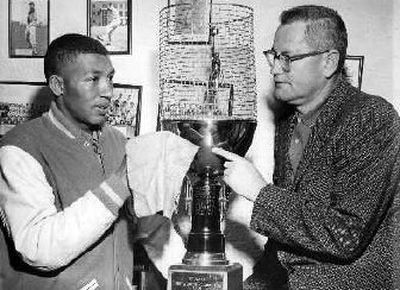Former GU coach Anderson dead at 84

Hank Anderson once jokingly credited his longevity as basketball coach at Gonzaga University to it being “the only school that would have me” – but that was a reach longer than he could manage even standing 6-foot-7.
The truth was, the Bulldogs were more than grateful to have him – and so were a couple schools after he left Gonzaga as the winningest basketball coach in the university’s history.
The architect both of GU’s move into major college basketball and its charter membership in the Big Sky Conference, Anderson died Monday morning of an aortic aneurysm in Gig Harbor. He was 84.
“The entire family was at Dad’s side when he passed away,” said Terry Anderson, one of Anderson’s five children. “It was a dignified and painless death.”
Dignity was a staple of Thor Henry Anderson. His manner of winning friends as well as games helped solidify Gonzaga’s basketball future through the 1950s and ‘60s, but it also rubbed off on the players he coached.
“Hank was a great motivator, but he was also just a good and decent man,” said Jerry Vermillion, one of Anderson’s first standout players at Gonzaga. “He was a mentor to a lot of guys. Some of us kind of set our lifestyles on the teaching and foundation he gave us.”
Himself a standout player at both Eastern Oregon and the University of Oregon, Anderson had coached high school basketball for seven years in the Oregon communities of Burns, Medford and Grants Pass when Gonzaga hired him in 1951 to succeed L.T. Underwood, who resigned after an 8-22 season.
The Bulldogs rebounded to a 19-16 record under Anderson, launching a 21-year tenure at Gonzaga that saw his teams go 290-275 during a time when he significantly upgraded Gonzaga’s schedule and often played more than 60 percent of that schedule on the road because of GU’s lack of a suitable on-campus facility.
That ended in 1965 with the completion of Kennedy Pavilion, known these days as Martin Centre, or “the Kennel” – another project spearheaded by Anderson, who also served as athletic director.
“Hank left a legacy at Gonzaga,” said current GU athletic director Mike Roth. “He definitely helped lay the foundation for what Gonzaga basketball has accomplished in recent years.”
With Vermillion at center, Anderson coached the Zags to the NAIB – precursor of the National Association of Intercollegiate Athletics – national tournament in 1953, where they lost in the first round to Southwest Missouri State. Six years later, the Bulldogs made the jump to what is now NCAA Division I, and in 1963 joined the fledgling Big Sky Conference, which Anderson was instrumental in founding.
The high point of his career was winning back-to-back Big Sky titles in 1966 and 1967 – though the Big Sky champion wouldn’t get a berth in the NCAA Tournament until the following season.
Anderson recruited and coached a number of the more legendary names in Gonzaga hoops – none more notable than Frank Burgess, who would lead the nation in scoring as a senior in 1961 with a 32.4-point average and remains the school’s all-time leading scorer. Arriving the year before Burgess came in 1958 was 7-foot-3 Frenchman Jean Claude Lefebvre (“he waded over,” Anderson would like to say), who would be featured in both Sports Illustrated and Life magazines, though he would stay for only two seasons.
Vermillion was not technically an Anderson recruit, but he would play all four of his GU seasons for the coach and compile rebounding records that will never be broken. Gary Lechman, a three-time All-Big Sky center at just 6-4, and Billy Suter were the driving forces behind the two championship teams.
Jim Dixon, Greg Sten, Charlie Jordan, Bill Quigg, Bob Hunt, Bill Wilson – all prominent on Gonzaga’s scoring and rebounding lists – also played for Anderson.
Anderson gave up the athletic director’s job in 1972 and weeks later surprised Gonzaga fans by accepting the head coaching position at Montana State. He coached the Bobcats for two seasons and then moved on to Northern Arizona as athletic director in 1974. He retired 10 years later.
His career coaching record was 318-299.
In addition to Terry Anderson, who lives in Spokane, Anderson is survived by his wife Betty in Tacoma, and daughters Patricia Mortensen (Carmel, Calif.), Colleen Johnson (Boise), Mary Simon (Oregon City, Ore.) and Liz Haley (Fox Island).
Funeral arrangements are pending.